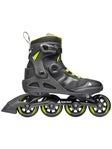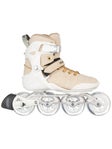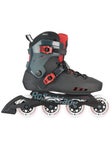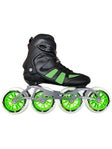How to Choose Cross-Training Inline Skates
Cross-training inline skates are often known as fitness skates or performance skates, but no matter what you call them, they are best suited for skating long distances or at high intensity as a means of exercise. Incorporating skating into workout routines has proven highly effective and makes getting fit - and staying there - more fun. Cross-training skates benefit these types of skaters at varying degrees of performance and cost. Inline Warehouse has a massive selection, so we've written this article to help you understand and pick the right skate!
Skill Level
As individual skills and confidence increase over time, so do the demands and expectations placed on equipment. That's why we include the recommended skill level for each and every skate model in its product description. It is important to correctly identify your own personal skill level - beginner, intermediate, advanced, or expert - and shop for a pair of skates that match or just slightly exceed where you are comfortable. A beginner buying advanced skates is going to have a hard time, in the same way an expert skater would be disappointed in the performance of beginner skates. If you are on the bubble, consider using our filter to search for two skill levels, such as Beginner and Intermediate. A skate that feels good and fits correctly will allow you to skate better, skate longer, and have more fun doing it!
In general, Beginner and Intermediate skates prioritize comfort while Advanced and Expert skates focus more on performance. Casual and inexperienced skaters often lack the strength, conditioning, and technique required to feel the benefits of high performance boots, instead preferring a softer, more relaxed fit that is more forgiving. But more skilled skaters will want a stiffer boot that is more responsive and efficient at transferring energy from each stride into their wheels. These high level skates often sacrifice comfort and ventilation but allow high level skaters to push longer distances at higher speeds.
Wheel Size
The diameter and configuration of the wheels on any skate are a good indication of its skill level and overall difficulty to use. Entry-level and casual skaters should limit their shopping to skates that have smaller wheels (80mm - 90mm). These shorter wheels help with overall ease, stability, and control - important factors for someone just starting out and building their confidence. Intermediate skaters have a larger range to choose from (90mm - 110mm), while advanced and expert skaters will typically enjoy the speed and roll of larger wheels (100mm - 125mm) but could easily ride any configuration they want.
Besides wheel size, the configuration of those wheels in the frame is also an important factor. The growing popularity of 3-wheel inline skates makes it so that a wider range of skaters can enjoy the benefits of larger wheels, but 3-wheel skates may not be right for every skater. We recommend checking out our Three vs Four Wheel Skate Comparison guide for more information on the differences between the two setups and which one may be best for you!
Skating Environment
Skill level is one important factor for considering wheel size, but the environment in which you will be skating can also help determine which wheels, and therefore which skates, are best.
If skating long distances without much stopping or maneuvering, such as in race settings or on open roads, then large wheels will cover the ground faster and maintain their roll more easily. Likewise, if skating in tight or crowded locations where frequent stops or quick changes in direction are necessary, such as urban areas, then small wheels will be more agile and easier to get up and down from speeds. If the roads or trails you will be skating are known for being bumpy, dirty, or filled with cracks, larger wheels have a better time rolling over and through obstacles like these and will provide a smoother ride.
You may find that your skating ends up being some combination of different environments and wheel requirements, which means that versatility is key. Finding a wheel size that's in the middle of your skill level range will offer a blend of speed and agility benefits. Another option is to find a separate wheel and frame assembly to add to your skate bag, since most cross-training skates have removable and adjustable frames. Changing your setup to match your environment is quick, easy, and very satisfying!
Summary
In conclusion, start by identifying your skill level and then look for skates with performance to match. Then, look for a wheel size that makes sense for the environment in which you will be skating most often. After that, features or aesthetics can help steer you towards a final decision, if needed.
And don't forget, our skate filter is extremely useful for sorting through the dozens and dozens of skate models we have available, and it is conveniently located at the top of every page on our site where you can shop for skates. With that filter, you can sort skates by skill level, wheel size, gender, and so much more! Be advised that when sorting for women's skates, unisex models will not be included in that search; we recommend searching women's and unisex for the best selection.








